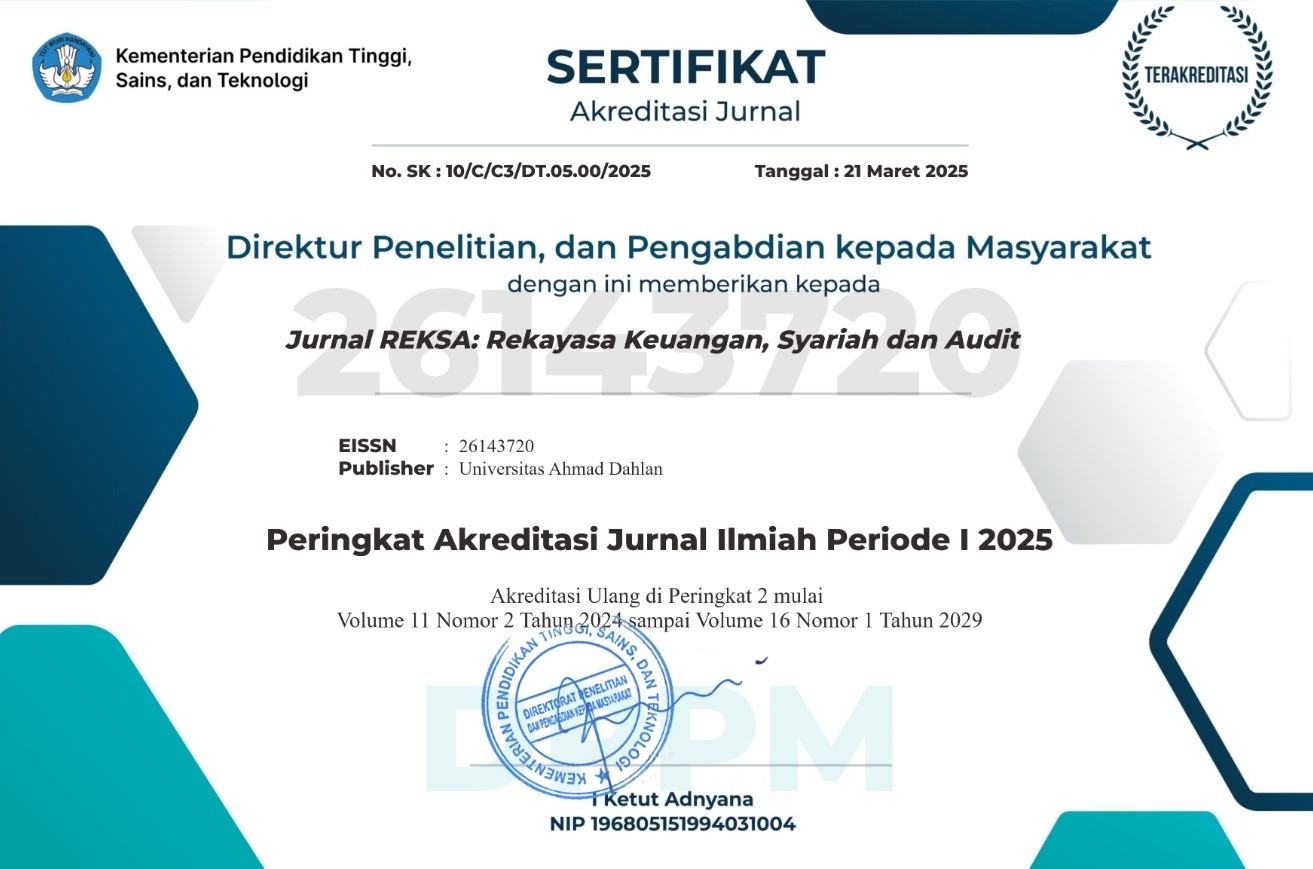Non-Performing Financing in Indonesian Islamic Commercial Banks During the Pandemic: A Macro and Microeconomics Perspective
DOI:
https://doi.org/10.12928/jreksa.v9i1.5831Keywords:
Autoregressive Distributed, Macroeconomic, Microeconomic, Covid-19Abstract
Non-performing financing (NPF) as a measure of the soundness of Islamic banks might face adverse reactions during the Covid-19 pandemic. This study aimed to determine the effect of macroeconomic variables, including inflation, BI rate, exchange rate, and microeconomic variables such as CAR, FDR, and BOPO on the NPF of Islamic Commercial Banks registered by the Indonesian Financial Services Authority for the period 2013:5 to 2021:6. It also aimed to investigate the effect of the covid-19 pandemic on the NPF. This study utilized the autoregressive distributed lag (ARDL) analysis method. The ARDL was used to analyze the relationship between NPF and the macro and microeconomics variables in the short and long term. The analysis results showed that the covid-19 pandemic, inflation, and BI rate significantly affected the NPF of the Indonesian Islamic commercial banks in the short and long term. Additionally, it was evidenced that BOPO was only significant in affecting the NPF in the short time, and FDR was only significant in determining the NPF in the long term.
References
Dahlan, R. (2014). Pengaruh Tingkat Bonus Sertifikat Bank Indonesia Syariah dan Tingkat Inflasi Terhadap Pembiayaan Bank Syariah di Indonesia. Jurnal Etikonomi. https://doi.org/10.15408/etk.v13i2.1881
Ekananda, M. (2016). Analisis Ekonometrika Data Panel. Mitra Wacana Media.
Hadiwardoyo, W. (2020). Kerugian Ekonomi Nasional Akibat Pandemi Covid-19. Baskara: Journal of Business and Entrepreneurship, 2(2), 83–92. https://doi.org/10.24853/baskara.2.2.83-92
Hilman, C., & Laturette, K. (2021). Analisis Perbedaan Kinerja Perusahaan Sebelum Dan Saat Pandemi Covid-19. BALANCE: Jurnal Akuntansi, Auditing Dan Keuangan, 18(1), 91–109. https://doi.org/10.25170/balance.v18i1.2659
Mutamimah, S., & Chasanah, N. Z. (2012). Analisis Eksternal dan Internal Dalam Menentukan Non Performing Financing Bank Umum Syariah di Indonesia. Jurnal Bisnis Dan Ekonomi (JBE), 19(1), 49–64.
Najiatun, Sanusi, M., Herianingrum, S., & Rahman, M. (2020). Analisis Variabel Makroekonomi Terhadap NPF Perbankan Syariah di Indonesia. Jurnal Ekonomi, 24(3), 335. https://doi.org/10.24912/je.v24i3.597
OJK. (2020). LAPORAN PERKEMBANGAN KEUANGAN SYARIAH INDONESIA 2020.
Priyadi, U., Utami, K. D. S., Muhammad, R., & Nugraheni, P. (2021). Determinants of Credit Risk of Indonesian Sharīʿah Rural Banks. ISRA International Journal of Islamic Finance. https://doi.org/10.1108/IJIF-09-2019-0134
Ramadiyah, R. (2014). Model Sistem Manajemen Resiko Perbankan Syariah Atas Transaksi Usaha Masyarakat. Menara Riau: Jurnal Kewirausahaan, 13(2), 220–248.
Soekapdjo, S., Tribudhi, D. A., & Nugroho, L. (2019). Pengaruh Fundamental Ekonomi dan Kinerja Keuangan Terhadap Kredit Bermasalah pada Bank Syariah di Indonesia. EkoNiKa : Jurnal Ekonomi Universitas Kadiri, 4(2), 126–139. https://doi.org/10.30737/ekonika.v4i2.327
Sudarsono, H., & Supriani, I. (2018). Analisis Pengaruh Variabel Mikro Dan Makro Terhadap NPF Perbankan Syariah di Indonesia. Equilibrium: Jurnal Ekonomi Syariah, 6(1), 1. https://doi.org/10.21043/equilibrium.v6i1.3040
Susanto, H., & Kholis, N. (2016). Analisis Rasio Keuangan terhadap Profitabilitas pada Perbankan Indonesia. Jurnal EBBANK, 7(1), 11–22.
Tahliani, H. (2020). Tantangan Perbankan Syariah dalam Menghadapi Pandemi Covid-19. Madani Syari’ah, 3(2), 92–113.
Widyaningrum, L., & Septiarini, D. F. (2015). Pengaruh CAR, NPF, FDR, dan OER Terhadap ROA Pada Bank Pembiayaan Rakyat Syariah di Indonesia Periode Januari 2009 Hingga Mei 2014. Jurnal Ekonomi Syariah Teori Dan Terapan, 2(12), 970–985. https://doi.org/10.20473/vol2iss201512pp970-985
Downloads
Published
How to Cite
Issue
Section
License
Copyright (c) 2022 Riska Dewi, Abdul Hakim

This work is licensed under a Creative Commons Attribution-ShareAlike 4.0 International License.
- Authors retain copyright and grant the JURNAL REKSA right of first publication with the work simultaneously licensed under a Creative Commons Attribution License (CC BY-SA 4.0) that allows others to share (copy and redistribute the material in any medium or format) and adapt (remix, transform, and build upon the material) the work for any purpose, even commercially with an acknowledgment of the work's authorship and initial publication in JURNAL REKSA.
- Authors are able to enter into separate, additional contractual arrangements for the non-exclusive distribution of the journal's published version of the work (e.g., post it to an institutional repository or publish it in a book), with an acknowledgment of its initial publication in JURNAL REKSA.
- Authors are permitted and encouraged to post their work online (e.g., in institutional repositories or on their website) prior to and during the submission process, as it can lead to productive exchanges, as well as earlier and greater citation of published work (See The Effect of Open Access).




